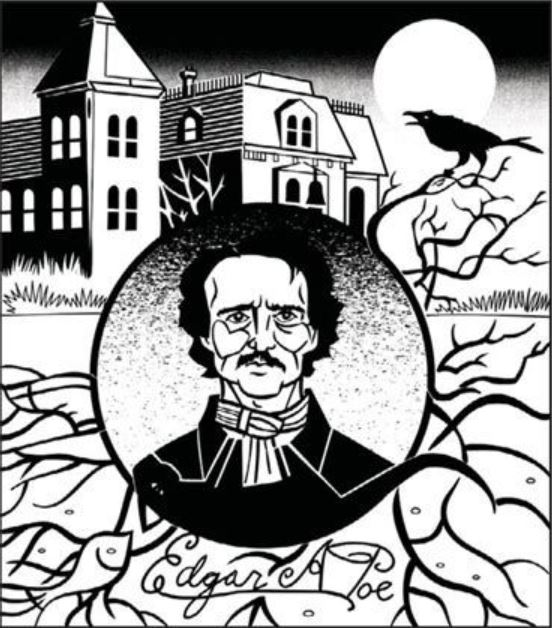Unveiling the Gothic Genius: Exploring Edgar Allan Poe’s Dark World
Edgar Allan Poe: The Father of Modern Horror
Edgar Allan Poe stands as a towering figure in American literature, revered for pioneering the Gothic and detective genres. Born in 1809, Poe’s short but turbulent life fueled his haunting tales and poems, each steeped in psychological depth and eerie atmospheres. From the cracked walls of decaying manor houses to the whispers of doomed lovers, Poe’s work continues to captivate readers, filmmakers, and artists alike. In this article, we’ll journey through the symbolic elements of a classic Poe tableau—his somber portrait, a looming haunted mansion, and the ever‐watchful raven—to uncover the themes and techniques that define his timeless allure.

A Portrait of Melancholy: Deciphering Poe’s Likeness
Poe’s own visage, as captured in countless engravings and illustrations, reveals the tormented soul behind the pen:
- Deep‐Set Eyes: Poe’s intense gaze, heavy with sorrow, speaks of personal loss—his mother’s early death and his struggles with grief.
- Sharp Features: The aquiline nose and high cheekbones lend a noble yet severe quality, mirroring the refined darkness of his prose.
- Shadowed Countenance: Artists often accentuate shadows under his brow and hollows of his cheeks, highlighting the psychological shadows that permeate his stories.
This portrait isn’t mere likeness; it invites us to peer into the mind that crafted nightmares of unquiet tombs and maddening obsessions.
The Haunted Mansion: Architecture of Terror
In the background, a forbidding manor—its windows dark, its spires reaching skyward—embodies the Gothic setting Poe perfected:
- Victorian Silhouette: Steep gables, turreted towers, and ornate cornices evoke 19th‐century architectural romanticism, a favorite stage for his tales.
- Isolation and Decay: Missing panes, climbing vines, and twisted branches suggest neglect and entrapment, amplifying the sense of psychological confinement.
- Threshold Imagery: Doorways and archways often symbolize transitions to death or madness in Poe’s work—each entry point looms like an invitation to the unknown.
By mastering this architectural lexicon, Poe transformed houses into characters—sentient witnesses to human folly and supernatural dread.

Nevermore: The Raven as Poe’s Dark Muse
No discussion of Poe is complete without his most iconic symbol: the raven perched under a pallid moon:
- Messenger of the Macabre: In Poe’s 1845 poem “The Raven,” the bird’s persistent “Nevermore” haunts a grieving lover, embodying inescapable mourning.
- Symbolic Darkness: Ravens, black as grief itself, connote death, fate, and unanswerable mysteries—perfect companions for Poe’s brooding narrators.
- Perched on the Threshold: Often illustrated on a gnarled branch or bust, the raven occupies liminal space—between life and death, reason and madness.
This feathered harbinger deepens the atmosphere, reminding us that at the heart of every Poe tale lies the shadow of loss and inevitability.
Themes of Obsession and Madness
Across Poe’s oeuvre, several interlocking themes emerge—vividly reflected in our composite image:
- The Allure of Death: From “The Masque of the Red Death” to “Annabel Lee,” Poe romanticizes mortality, portraying it as both seductive and terrifying.
- Psychological Unraveling: His protagonists often teeter on the brink of sanity—obsessed with lost love, secret tombs, or spectral visitors—echoing the hollow look in Poe’s eyes.
- The Uncanny and Unseen: Shadows that move, whispers in the night, and hidden chambers underscore the fear of what lies beyond perception.
By weaving these motifs together, Poe invites us to confront our deepest anxieties—an experience as chilling now as it was in the 19th century.

Poe’s Lasting Legacy: From Page to Screen
Edgar Allan Poe’s influence extends far beyond his lifetime:
- Detective Fiction Pioneer: “The Murders in the Rue Morgue” introduced C. Auguste Dupin, planting the seeds for Sherlock Holmes and modern crime thrillers.
- Cinematic Inspirations: Filmmakers like Roger Corman and Tim Burton have adapted Poe’s tales, each adding new visual flair to his gothic visions.
- Literary Homages: Contemporary authors continue to reference Poe’s themes—obsessive love, unreliable narrators, death’s inevitability—testament to his undiminished relevance.
Through each retelling, the haunted mansion’s silhouette, Poe’s haunted eyes, and that ominous raven endure as emblems of the Gothic imagination.

Conclusion: Embracing the Eternal Midnight
Edgar Allan Poe’s world—where crumbling estates echo with footsteps, ravens croak prophecies, and every mirror may hide a specter—remains a fertile canvas for our darkest dreams. By deciphering the visual symbols in Poe’s portrait, the foreboding mansion, and the sentinel raven, we glimpse the intricate interplay of loss, obsession, and the supernatural that fuels his lasting appeal. So the next time you feel a chill breeze rustle through leafless branches or catch a raven’s silhouette against a pale moon, remember Poe’s enduring invitation: to wander willingly into midnight’s embrace and discover the beauty within the macabre.





